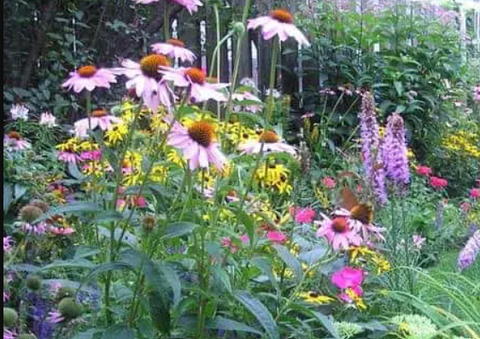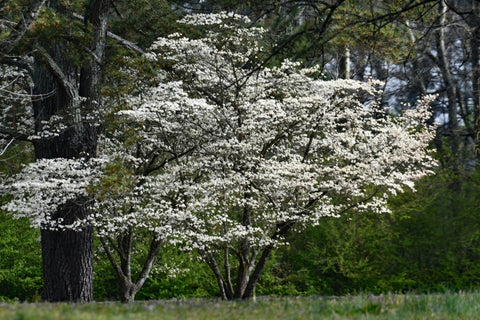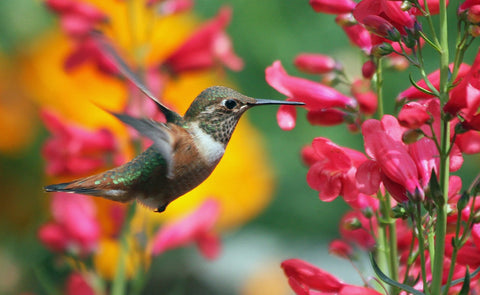There are many wonderful flowering perennials that offer nectar and pollen to pollinators, are frequented by butterflies and hummingbirds, are host plants to various caterpillars, and flower for months throughout the summer.
Monarda didyma or Bee Balm can grow from 18 inches to 4 feet depending on the variety. For attracting hummingbirds Monarda didyma Jacob Kline with its vibrant red flowers does well. This variety will grow to 4 feet tall and may need support if planted in a windy location. Monarda prefers full sun and well-draining soil. Monarda can get powdery mildew if air circulation is minimized so either allow for good air circulation or front plant so only the upper portion of the stems with the flowers are visible. It is worth having for its color and fascinating flower.
may need support if planted in a windy location. Monarda prefers full sun and well-draining soil. Monarda can get powdery mildew if air circulation is minimized so either allow for good air circulation or front plant so only the upper portion of the stems with the flowers are visible. It is worth having for its color and fascinating flower.
Rudbeckia or Black-Eyed Susans are native to our area and there are a few varieties commonly called by that name.
-
Rudbeckia fulgida fulgida, a native variety is a variable species that can grow from 1-3 feet tall. Leaves are usually covered in bristles which deter deer. The flowers can start blooming in June and continue through late August. The plant prefers moist soils and can be found in meadows, pastures, open woodlands, and hedgerows.
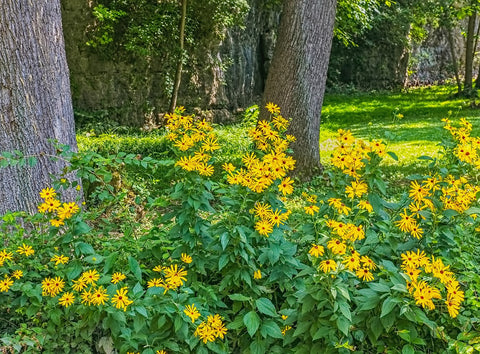
-
Rudbeckia deamii has slightly larger leaves and grows in more of a clump. Growing to 18-24 inches by the same it too has bristles on the leaves that deter deer.
-
Rudbeckia fulgida ‘Goldsturm’ is another variety that only grows to 18 inches tall and wide. It will bloom from July into late August. Rudbeckia maxima is one of our larger growing topping off between 4-6 feet tall with basal foliage growing 2 feet across and tall. The cones on the flower project out from the petals and provide seeds to our songbirds during fall migration.
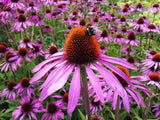
Echinacea or Coneflower is often listed as native but the true native variety that grows in our area the best is Echinacea purpurea or the pink flowering variety. This plant has evolved with our native pollinators and birds for thousands of years. Most of the others are crosses or hybrids that we have developed.
Lobelia are also favored by hummingbirds and butterflies.
-
Lobelia cardinalis is another red flowering plant that attracts hummingbirds. Cardinalis like full sun to part shade and moist soils. Natively you can find the plant growing on sunny banks near streams.
-
Lobelia siphilitica or the Great Blue Lobelia prefers more shade and moist organic well-draining soils. Although blue in color its tubular flowers also attract hummingbirds.

Gaura lindheimeri is another summer flowering perennial that is commonly called whirling butterfly. The flowers are born along a strong long stem that dances in the garden. Depending on the variety the flowers can be pure white, pink, or picotee. They prefer full sun and well-drained organic soils.
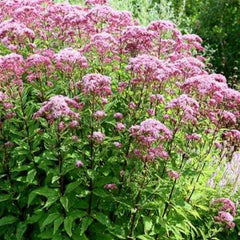
Later in the summer Eupatorium varieties begin to flower and last into fall. These plants are hardy and usually grow 4-6 feet tall. Their flowers provide much-needed nectar and pollen to butterflies and bees. The stems are often home to native solitary bees. The seed heads in fall are eaten by migrating songbirds. This plant can grow in shade to full sun with adequate moisture.
Liatris provides for bumble bees and butterflies from July into fall.
-
Liatris spicata is a prairie perennial that develops from a corm and can grow to 3-6 feet tall. The common name is Gayfeather as the large purple flower spike resembles a feather.
-
Liatris spicata Kobold is a cultivated variety that grows to 3 feet tall
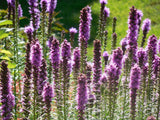
and does not require staking. The plant prefers organic soils that are slightly moist and have good air circulation. They do not like wet winters. Seeds may be collected and cold vernalized for 40 days in a refrigerator, scarified, and spread. If planted from seed, it will take 2 years for the plant to flower.
These native plants have been in existence for thousands of years and co-exist with our native bees and butterflies so if you want to help our pollinators, try some of these varieties

